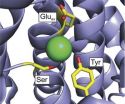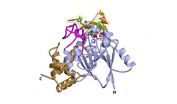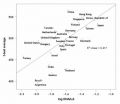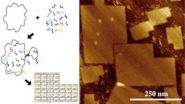(Press-News.org) With the rise of emerging economies around the world and a concomitant upgrade of health care systems, the global population has been rapidly expanding. As a consequence, worldwide demand for agricultural products is also growing.
Crops now provide food and the other important resources for seven billion humans.
Food supplies are primarily based on such crops as wheat, maize, rice and vegetables. But as the area of arable land and of cultivated land continues to decline, the future ability to meet the world's food security needs has come under a cloud of uncertainty.
Meanwhile, the use of pesticides and fertilizers has triggered long-term adverse effects on the environment, and has presented a serious threat to human health.
These problems and threats have caused scientists across the continents to search for solutions aimed at improving the production of grain to meet the needs of the growing global population and at bolstering the pest resistance of crops while reducing the use of chemical pesticides.
Proponents of new technologies including DNA recombination have promised a new green revolution, with genetically modified crops featuring transgenes achieving targeted traits including improved quality, increased production, and resistance to pests and stress. Unfortunately, safety concerns with respect to food and the environment caused by the expression of exogenous genes in crops have been raised.
Yet now, using non-coding RNA (ncRNA) to improve crops provides a new alternative.
Non-coding RNAs refer to transcripts that do not code for proteins, but play important regulatory roles in the cell, which excludes the possibility of producing exogenous protein products. Non-coding RNAs can be classified into two major groups: small non-coding RNA (siRNAs, miRNAs, and piRNAs) with a length of 20-30 nucleotides and long non-coding RNAs with a length of more than 200 nucleotides.
Advances in honing non-coding RNAs to enhance crops and in gRNA-guided genome editing are outlined in a new study entitled "Non-coding RNAs as potent tools for crop improvement," published in the Beijing-based journal National Science Review. Co-authors Renyi Liu, of the Shanghai Institutes for Biological Sciences, part of the Chinese Academy of Sciences, and Jiankang Zhu, concurrently based at SIBS and at Purdue University, state in the study that non-coding RNAs are now understood to play important roles in gene regulation.
"The functional roles of small RNAs in RNA-directed DNA methylation, viral defense, transposon suppression, abiotic and biotic stress responses, DNA double-strand break repair, and plant development have been demonstrated," they state in the article. "These advancements in basic research have greatly increased our knowledge of plant ncRNAs and facilitated the effective design of ncRNA-based strategies for crop improvement. ncRNAs function by repressing the expression of endogenous or exogenous genes at the transcriptional, post-transcriptional, or translational levels in a sequence-specific manner … [and] can be used to specifically control the expression of target genes."
RNA genetic engineering has contributed significantly to two of the major goals of crop enhancement: resistance to pests and pathogens and improved nutritional value.
"RNA interference (RNAi) evolved as a defense mechanism against invading nucleic acid molecules such as those from viruses," the scholars write in the National Science Review.
Discoveries surrounding RNA have transformed it into a powerful tool of genetic engineering and functional genomics aimed at producing better agronomic traits.
RNA silencing-based technology has enjoyed success in improving the nutritional value of crops. By down-regulating key genes in plant metabolic pathways using RNAi constructs, transgenic crops may accumulate more favorable metabolites or produce less unwanted ingredients. Examples include corn with increased essential amino acids, soybean, canola and cotton with improved fatty acid composition, wheat with increased fiber content, alfalfa and poplar with reduced lignin, and soybean, rice, peanut, and apple with reduced allergens.
"A recent and exciting ncRNA-based technology is the clustered regularly interspaced short palindromic repeat (CRISPR)/CRISPR-associated (Cas) technology for gene editing in plants," they point out in the review.
CRISPR/Cas is a bacterial defense strategy against invading DNA such as phages or plasmids.
In this strategy, the CRISPR ncRNA guides a Cas endonuclease to cleave invading homologous DNA. Engineered CRISPR single guide RNAs (sgRNAs) and the Cas9 endonuclease can be expressed in transgenic plants, so that the Cas9 generates double-stranded DNA breaks at target genes that are complementary to the sgRNA sequences.
"Through cellular DNA repair, mutations or corrections of the target genes can be achieved," the scholars state. "This CRISPR/Cas-based gene editing or genome engineering technology is a very powerful tool for plant functional genomics and crop improvement."
RNAi-based technologies have proven to be potent tools for crop improvement.
"As genomic resources for major crops and pests and pathogens are accumulated at a fast pace, additional target genes will be exploited for crop improvement," predict Renyi Liu and Jiankang Zhu. "RNAi-based technologies also have the potential to play a major role in achieving other goals for crop improvement such as increased yield and enhanced resistance to abiotic stresses once the relevant pathways are better understood."
INFORMATION:
This research was supported by the Chinese Academy of Sciences.
See the article: Renyi Liu and Jiankang Zhu. Non-coding RNAs as potent tools for crop improvement. National Science Review, 2014 Vol.1 (2): 186-189
http://nsr.oxfordjournals.org/content/1/2/186.full
The National Science Review is the first comprehensive scholarly journal released in English in China that is aimed at linking the country's rapidly advancing community of scientists with the global frontiers of science and technology. The Review also aims to shine a worldwide spotlight on scientific research advances across China.
Crop improvement and resistance to pathogens benefits from non-coding RNA studies
2014-09-11
ELSE PRESS RELEASES FROM THIS DATE:
Last decade's slow-down in global warming enhanced by an unusual climate anomaly
2014-09-11
A hiatus in global warming ongoing since 2001 is due to a combination of a natural cooling phase, known as multidecadal variability (MDV) and a downturn of the secular warming trend. The exact causes of the latter, unique in the entire observational record going back to 1850, are still to be identified, according to an article by the European Commission's Joint Research Centre (JRC).
The earth hasn't warmed at the same pace during the 20th century. The noticeable temperature increases during some periods interspersed with fairly stable or decreasing levels during others ...
The quantum revolution is a step closer
2014-09-11
Theories show how computing devices that operate according to quantum mechanics can solve problems that conventional (classical) computers, including super computers, can never solve. These theories have been experimentally tested for small-scale quantum systems, but the world is waiting for the first definitive demonstration of a quantum device that beats a classical computer.
Now, researchers from the Centre for Quantum Photonics (CQP) at the University of Bristol together with collaborators from the University of Queensland (UQ) and Imperial College London have increased ...
VALUE study reports on accreditation status
2014-09-11
SEPTEMBER 2014 | Ellicott City, MD – The Intersocietal Accreditation Commission (IAC) announced today that researchers from the University of Miami Miller School of Medicine have published a manuscript in Vascular Medicine analyzing a random national sample of Medicare beneficiary data to determine the outpatient vascular testing facilities' accreditation status and geographic location. The study manuscript entitled, "Accreditation Status and Geographic Location of Outpatient Vascular Testing Facilities Among Medicare Beneficiaries: The VALUE (Vascular Accreditation, Location ...
Bully victims more likely to suffer night terrors and nightmares by age 12
2014-09-11
Children who are bullied at ages 8-10 are more likely to suffer from sleep walking, night terrors or nightmares by the time they are 12 years old.
In a study published this week in Pediatrics, journal of the American Pediatric Association, Professor Dieter Wolke and Dr Suzet Tanya Lereya from the University of Warwick, found being bullied increases the risk for a category of sleep disorders known as parasomnias. These are sleep-related problems such as nightmares, night terrors or sleep walking.
A cohort of children from the Avon Longitudinal Study of Parents and Children ...
Study: Cat bites dog
2014-09-11
NEW YORK (September 11, 2014) – A new study led by the Wildlife Conservation Society reveals that in India's human dominated agricultural landscapes, where leopards prowl at night, it's not livestock that's primarily on the menu – it is man's best friend.
The study, which looked at scat samples for leopards in India's Ahmednagar's district in Maharashtra, found that 87 percent of their diet was made up of domestic animals. Domestic dog dominated as the most common prey item at 39 percent and domestic cats were second at 15 percent.
Seventeen percent of the leopard's ...
Is the pattern of brain folding a 'fingerprint' for schizophrenia?
2014-09-11
Philadelphia, PA, September 11, 2014 – Anyone who has seen pictures or models of the human brain is aware that the outside layer, or cortex, of the brain is folded in an intricate pattern of "hills", called gyri, and "valleys", called sulci.
It turns out that the patterns of cortical folding are largely consistent across healthy humans, broadly speaking. However, disturbances in cortical folding patterns suggest deeper disturbances in brain structure and function.
A new study published in the current issue of Biological Psychiatry suggests that schizophrenia is associated ...
How bacteria battle fluoride
2014-09-11
He's not a dentist, but Christopher Miller is focused on fluoride. Two studies from his Brandeis University lab provide new insights into the mechanisms that allow bacteria to resist fluoride toxicity, information that could eventually help inform new strategies for treating harmful bacterial diseases. The studies appear in The Journal of General Physiology (JGP).
Although most animal cells are protected from direct exposure to fluoride, this toxic element is a serious threat to single-celled organisms like bacteria and yeast. As a result, their plasma membranes carry ...
Structure of enzyme seen as target for ALS drugs
2014-09-11
VIDEO:
In this movie, the Dbr1 enzyme rotates 360 degrees. Partially inhibiting Dbr1 could represent a new way to treat most cases of amyotrophic lateral sclerosis (ALS), according to a new...
Click here for more information.
SAN ANTONIO, Texas, U.S.A. (Sept. 10, 2014) — Investigators from the School of Medicine at The University of Texas Health Science Center at San Antonio have determined the first high-resolution structure of an enzyme that, if partially inhibited, could represent ...
Hold the mayo
2014-09-11
You are what you eat, the saying goes, and now a study conducted by researchers at UC Santa Barbara and the University of Pittsburgh suggests that the oft-repeated adage applies not just to physical health but to brain power as well.
In a paper published in the early online edition of the journal Prostaglandins, Leukotrienes and Essential Fatty Acids, the researchers compared the fatty acid profiles of breast milk from women in over two dozen countries with how well children from those same countries performed on academic tests.
Their findings show that the amount of ...
Researchers create world's largest DNA origami
2014-09-11
Researchers from North Carolina State University, Duke University and the University of Copenhagen have created the world's largest DNA origami, which are nanoscale constructions with applications ranging from biomedical research to nanoelectronics.
"These origami can be customized for use in everything from studying cell behavior to creating templates for the nanofabrication of electronic components," says Dr. Thom LaBean, an associate professor of materials science and engineering at NC State and senior author of a paper describing the work.
DNA origami are self-assembling ...





